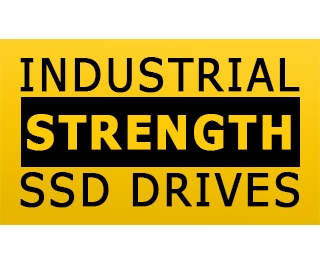Brands will throw the words semi-industrial, durable, and high-performing on anything to gain your business. But when it comes to electrical components, much of the stuff on shelves is no more “industrial” than an extra-strength Tylenol. Sure much like most automobiles, the basic mechanics of two separate SSDs are the same; but expecting a consumer-grade solid state drive to handle the demands of a complex networked environment is a lot like sending an off-the-lot truck to do the job of a semi: it only works in commercials and with safety crews standing by.
Choosing an SSD that will meet the rigorous demands of your operation doesn’t need to be difficult, but you should understand how the SSD will react to the specific challenges of your network environment, including extreme temperatures or disruptive vibrations.
Despite rapidly decreasing SSD costs in comparison with the nearly-nonexistant rate of innovation in traditional magnetic drives, the investment still needs to suit your needs. We’ll show you what to look for when comparing different SSDs to ensure your drive is fast, durable, and reliable enough to get the job done.
An Industrial Strength SSD Works As Hard As You
Consumer electronics are specified for use in the 0 to 70°C temperature range, unsuitable for those in the aerospace, military, oil and gas exploration, or even the automotive industries. Industrial applications that demand SSDs operate outside of the recommended conditions could be as simple as communication devices used in exploration where rapid cooling is not possible, or operating under the high pressure conditions in avionics.
When it’s vital that your solid state drive be extreme temperature resistant, save yourself time by limiting your search to industrial strength drives. These robust and durable solid state drives are built with the technology to withstand temperatures ranging from minus 45 to 85°C, reducing costly downtime and frequent replacements.
Know What Your SSD is Made Of
The DIGISTOR blog has been pretty vocal about the importance of concerning yourself with the list of components that comprise the larger products you purchase, otherwise known as the bill of materials (BoM) and we’re excited to see a recent Think Tank article promote our voice when exploring the complex issue that is BoM inconsistency.
We continue to speak about the importance of consistency, as some manufacturers aren’t using the same components across their products. A problem which can cause issues with a product’s “completeness or correctness” and affecting not only its performance but the drive’s compatibility with your network.
It’s important to look past flashy advertisements and glorified promotional specs to understand the relationship a product’s various components have with the whole: Many manufacturers, especially those that pursue low cost strategy, have shown an inability to use the same components or control their manufacturing process., which is yet another reason for prospective SSD customers should be especially vigilant of consistency in manufacturing when selecting a solution.
Pledging Consistency
As solid state drives become a more popular cost-effective solution, the demand for regularity and transparency is met by manufacturers of quality solid state drives with locked BoMs to ensure their quality.
A locked BoM is a promise of identical components used in the five most critical items of your SSD: Connector, PCB, Flash Controller, Flash Component and Firmware. This not only ensures that the components of a SSD meet the recommended operating conditions that you require, consistency is important when your established network calls for exact components when successfully integrating additional equipment.
As an end-user, it’s important to trouble yourself with the details to ensure a drive’s performance and reliability. Accurate, uniform manufacturing standards create the foundation of a brand’s ability to deliver on their promise, and ultimately, a product’s ability to meet your expectations.


Recent Comments